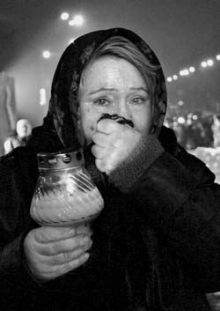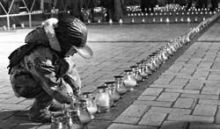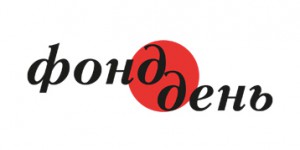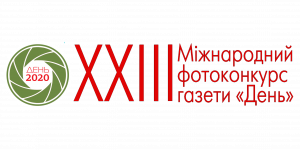I remember an illustration in my textbook on the history of the ancient world: tiny figures of Egyptians are hoisting a huge slab, with the aid of levers, to the sloping side of a giant pyramid to perpetuate the memory of their ruler Cheops. Man can do only so much using his muscles, but a lever helps resist the force of gravity on a slab of rock.
When I began this article, I remembered that illustration from my distant childhood. By a remarkable coincidence the Communist Party of Ukraine, which has long been a marginal political force, has found itself, much to its own and others’ surprise, in possession of a lever that is increasing its influence on our society many times over. Without this party’s votes the parliamentary majority is not a majority.
A couple of weeks ago there was a program on television, showing the opposition MPs in Ukraine’s parliament walking past the podium after the adjournment of a session and dropping slim white booklets on the floor. No matter how many times I asked my parliamentarian friends, no one had the booklet that was distributed by the communists to influence the vote on the president’s bill on the Holodomor of 1932-33 in Ukraine. I finally found a copy.
I have never publicly responded to articles written about me in the communist press. These articles are penned by people my own age, and I have no moral right to complain because in the past, which now seems to belong to the other world, I shared their views. That was the way I was raised by the Soviet school, as was the rest of my generation that had not experienced mass repressions or received any information from their parents about the actions of the Soviet regime in Stalin’s time. Paving the way for other scholars studying the Holodomor, I changed my earlier views as a result of this work, which helped me to look at the history of the Soviet period in a different way.
However, I am convinced that Comrade Tkachenko’s booklet deserves a response. We must not allow the dead to hold the living by the throat. Stalin, Kaganovich, Molotov, Postyshev, and the other organizers of the Holodomor must remain in their graves.
COMRADE TKACHENKO’S ARGUMENTS
Attacking people who began to remove the blinders of Soviet history during the Gorbachev period (these “manipulators of consciousness” ”include Yakovlev, Pozner, Korotych, Nemtsov, and Svanidze, and me, the only Ukrainian mentioned), the author of the booklet, one H. S. Tkachenko, Ph.D., declares that the tribunal of history has completely acquitted the collective/state farm system: “After the devastating hurricane of ‘democratic’ (bourgeois) reforms the absolute majority of peasants are becoming increasingly nostalgic for the collective farm system and the Soviet way of life.” (p. 18).
Although historically it was of very short duration, the period of the collective farm system embraced the most horrible tragedy in the 1,000- year history of the Ukrainian people: the Holodomor. Why did it become possible?
Tkachenko admits that a famine took place. Since there was a famine and the state did not create it — in the communists’ opinion — the author tries to determine the reason for the deaths of millions of peasants. Allegedly there were two factors: an objective one, namely, a poor harvest caused by a drought, and a subjective one, namely acts of sabotage by kulaks (pp. 12, 14).
In January 1933 Stalin carried out a punitive operation in Ukraine’s rural areas by confiscating all food reserves. In specifying the cause of the failed grain deliveries at the January plenary meeting of the CC AUCP(B), he accused the Ukrainian peasants of sabotage, and local party-Soviet authorities of having betrayed the interests of the party. His address made it clear that there was no drought in 1932 and that people, not the weather, were to blame for the grain delivery failures.
The author of this booklet may not have read Stalin, but he definitely read Stanislav Kosior’s report to the February 1933 plenary meeting of the CC AUCP(B) because later in the booklet he refers to a book in which it was published. Kosior echoed Stalin and cited harvest yield statistics for 1931 and 1932. Therefore, Tkachenko is familiar with this conclusion.
Tkachenko’s other statement reads like this: “The main cause of the famine in the early 1930s of the past century was kulak sabotage” (p. 14).
To make the Holodomor the result of sabotage, you need to have kulaks. Kulaks did exist in the Ukrainian countryside, but they vanished during the course of the agrarians reforms in 1920-23. These reforms boiled down to the liquidation of land exploitation by landlords and kulaks and a leveling redistribution of farmland. However, the term “kulak” vanished from Soviet legislation for only a short while. It started being used again in 1925. The government needed the kulak as a bugbear to incite the impoverished strata of the peasantry against the better— off ones, and to threaten those opposed to collectivization with dekulakization.
At the beginning of 1930 the Cheka deported all the kulaks to the Far North. However, after the publication of Stalin’s article “Dizzy with Success: Problems of the Kolkhoz Movement,” the middle peasants left the collective farms. To get them back, kulaks had to be found. In 1931 the peasants who opposed collectivization were branded as kulaks; if they were too poor, they were purged as subkulaks. Finally, in 1932-33, Stalin ordered the Bolshevization of the collective farms and declared that kulaks, who had infiltrated them, were to blame for sabotage on the farms. Tkachenko repeats what the Stalinist propagandists kept saying during the Holodomor: the peasants were to blame for the fact that they were starving.
If this thesis sounds abstract, it may elicit only philosophical reflections: like the Bourbons, the communists have forgotten nothing, but neither have they learned anything. Tkachenko, however, is not content with abstract reflections: he tries to prove them by providing concrete examples from a memorandum submitted by the Novopskovsk raion committee of the CP(B)U to the Donetsk oblast party committee (April 5, 1933). This memorandum is included in a collection of documents recommended for publication by a resolution of the Politburo of the CPU (Jan. 26, 1990). To illustrate the treacherous activities of “kulak saboteurs,” he quotes the following gems from this document: “...in the village of Oleksiivka the kulak Trokhym Neshcheret died of hunger, whereupon a pit filled with corn was discovered. In the village of Makartetyno, Olena Popova’s husband starved to death, the children are lying swollen from starvation, and 7 poods of corn, beans, sunflower, etc., were found in her home. In the same village Semen Streltsov, who declared that he was starving, was found in possession of 8 poods of rye and 3.5 poods of corn” (pp. 13-14 in the booklet; pp. 484-85 in the collection of documents).
In addition to grain, Stalin confiscated all food supplies collected by the peasants for the new harvest in order to nip in the bud the Ukrainian countryside’s insurgent potential. After this action the peasants became completely dependent on the state, which was now willing to save them from death by starvation. However, Pavel Postyshev, who replaced Molotov in January 1933, saved only those who agreed and were physically able to work for the state on their collective farms.
Terror by famine played a dual role: first, as a preventative measure against mass uprisings in the Ukrainian countryside, which took place in early 1930 and forced Stalin to temporarily halt all-out collectivization; and second, it was geared to halt spontaneous peasant sabotage caused by the peasants’ reluctance to work on collective farms in return for paper workday tickets. The first reason was carefully concealed, while the second was widely publicized in the Soviet press from a specific angle: kulak sabotage had supposedly brought the country to the verge of starvation and therefore had to be overcome by all means, including levies of fines in kind.
Tens of thousands of workers were sent from the cities to take part in Stalin’s operation to confiscate all peasant foodstuffs under the guise of grain deliveries. The workers’ bread rations were substantially reduced because of “kulak sabotage.” Led by Chekists, tens of thousands of undernourished and impoverished people took part in searching peasant homes, turning them inside out. They were given a percentage of fines in kind that were levied on peasants who had accumulated “debts” in terms of grain deliveries.
The people who were confiscating food from the peasants had no idea of the scale and consequences of the satanic campaign that was unfolding under the supervision of Molotov and Kaganovich. They were convinced that they were taking part in a patriotic struggle against kulak sabotage. Ukraine’s party and Soviet leadership knew what was happening. Some mustered the courage to resist it, while others fled to other regions of the USSR or enthusiastically carried out the instructions of the Communist Party rulers.
Ukrainian People’s Commissar of Agriculture A. Odyntsov, after visiting Uman and Shpola raions [in Cherkasy oblast and] Bila Tserkva raion in Kyiv oblast, noted in an official report: “People’s consciousness is evolving, including starving individuals, as is their anger at idlers and criminals. Conscientious collective farmers are in favor of punishing idlers and thieves with death by starvation.” During his lecture a “political worker” from the Prydniprovska Division, whose men also took part in Stalin’s food confiscation action, scolded the peasants for their refusal to work on the collective farms, adding, “That is why they are starving, but no one is to blame for this; let the idlers take care of themselves, they should remember Lenin’s slogan: ‘He who does not work does not eat!’ We know that the bourgeoisie, kulaks, and idlers do not work, so let them not eat.”
Such statements give one the shivers. However, the functionaries of the Stalinist period can be understood because they were balancing on a razor’s edge; if they failed to carry out orders from the center, they would die. But how can one understand Tkachenko, who swallows this cynical vomit of the raion party committee functionaries? What makes the leaders of the communist faction feed this vomit to the rest of the MPs in the session hall of the Verkhovna Rada of Ukraine?
One could spend much more time analyzing Tkachenko’s booklet, but is it worth it?
TWO DRAFT LAWS
On Nov. 17, 2006, the Verkhovna Rada was supposed to deliberate the Ukrainian president’s bill on the Holodomor of 1932-33. It did not because of lack of time, because there more important issues to deal with.
It would not do any good for the factions of the anticrisis coalition to quarrel with the communists, who would rather die than change their stand on this question. And so the Party of Regions faction tabled an alternative bill. Except for two “details,” it is an exact replica of the president’s.
Whereas the latter refers to the Holodomor of 1932-33 as an act of genocide against the Ukrainian nation in Article 1, the one drafted by the parliamentarians defines it as an act of mass destruction and a national tragedy of the Ukrainian people. Article 2 in both bills reads almost the same way: “Public denial of the Holodomor of 1932-33 in Ukraine is an act of outrage upon the memory of the millions of victims of the Holodomor, humiliation of the dignity of the Ukrainian people.”
The difference is the word at the end of the quote, which is in the presidential bill but not in the other one; also the words “shall be prohibited.” In everyday life we use the principle formulated by Boris Yeltsin: “Everything that is not prohibited is permitted.” Therefore, the MPs will allow, by the authority of the law, acts of outrage to be perpetrated against the memory of millions of Holodomor victims and the humiliation of the Ukrainian people’s dignity.
That’s not all. Tkachenko’s booklet has become a fact of life in Ukraine’s parliament. By voting for their bill, which will not become a law because the president will not sign it, the majority of MPs will demonstrate their solidarity with its content. This will be the worst act of outrage upon the memory of the Holodomor victims.
RUSSIA’S STANCE
The question of the Holodomor as an act of genocide is being discussed not just by domestic political forces. There is another active participant in the discussion: the Russian government. On Nov. 13 Russia’s foreign ministry published a statement aimed, as the document stresses, against the politicization of the subject of the famine. “Available archival materials attest that the mass famine of the early 1930s was indeed caused in many respects by the policy of the then Soviet leadership. However, it is perfectly clear that it was not conducted along national lines.” The statement further emphasizes that the tragedy claimed millions of Ukrainian lives, Russians, Kazakhs, and representatives of other peoples of the Soviet Union, and that it is our common grief and memory.
The impression is that the Russian foreign ministry statement appeared in response to a resolution passed during a rally of right-wing forces on Mykhailivska Ploshcha in Kyiv (Nov. 7) demanding compensation for the Holodomor victims from the Russian Federation.
Such demands should not worry Russia. First, the number of surviving Holodomor victims is scant because the tragedy occurred more than 75 years ago. Second, the Russian Federation is considered the legal successor to the Soviet Union, but it cannot be held responsible for the Holodomor in principle; not politically, legally, or morally. When the USSR was formed, the CC of the RCP(B) and the Council of People’s Commissars of the RSFSR were reorganized as all-Union bodies. The Bolshevik leaders did not allow a Russian Communist Party and Soviet center to appear in Moscow in order to prevent the emergence of competing political structures.
The Russian Federation was allowed to have only a weak Council of People’s Commissars that had jurisdiction over a limited number of entities of minor importance. It was only during the political democratization under Mikhail Gorbachev that the Soviet Russian center became full fledged and immediately challenged the all- Union one. Ukraine followed suit, and the power play in Moscow between the all-Union imperialist center and Yeltsin’s Russia helped it realize its constitutional right to independence.
The Bolshevik Kremlin leaders were equally ruthless toward people of all nationalities, but repressions were perpetrated along social as well as national lines. The entire Stalinist period is packed with evidence, and there is no sense in citing generally known facts.
Why is the Russian side so adamantly opposed to the designation of the Holodomor as genocide? Clearly, this is not linked to the groundless appeals of right-wing forces for moral and material compensation for the Holodomor victims from the Russian government, although the Russian press is giving them disproportionately large coverage.
The Holodomor of 1933 cannot be regarded as a one-time phenomenon. Confiscation of all foodstuffs in the countryside and the total cessation of Ukrainization in the Kuban region, vicious attacks on “traitors” in the party-Soviet apparatus, “national deviationists” in the party and government, “Ukrainian bourgeois nationalists” among the intelligentsia, a thorough purge of the 500,000-strong Communist Party of Ukraine — all these phenomena are of the same order. The Kremlin was afraid of Ukraine even in the straightjacket of Soviet statehood, so it used preventive terror in an attempt to suppress the Ukrainian national spirit. Stalin destroyed Ukrainians, by means of famine and other repressions, not as representatives of an ethnos but as citizens of the Ukrainian state.
All things considered, Moscow understands the nature of the genocide in Ukraine. However, if the Russian government recognized the Holodomor as an act of genocide, this would be tantamount to recognizing Ukraine as a state during the period before 1991.
The representatives of the Party of Regions in parliament should think twice before agreeing with the Russian side’s point of view. Everybody realizes that the bill on recognizing the Holodomor as genocide will have no consequences for anyone. It cannot be regarded as an unfriendly move against Russia.
However, its historical assessment answers national interests. Conversely, rejecting this assessment contradicts the national interests of Ukraine while meeting Russia’s imperial interests, if any. I do not think that the Russian government will give an affirmative answer to the question about its imperial interests.









